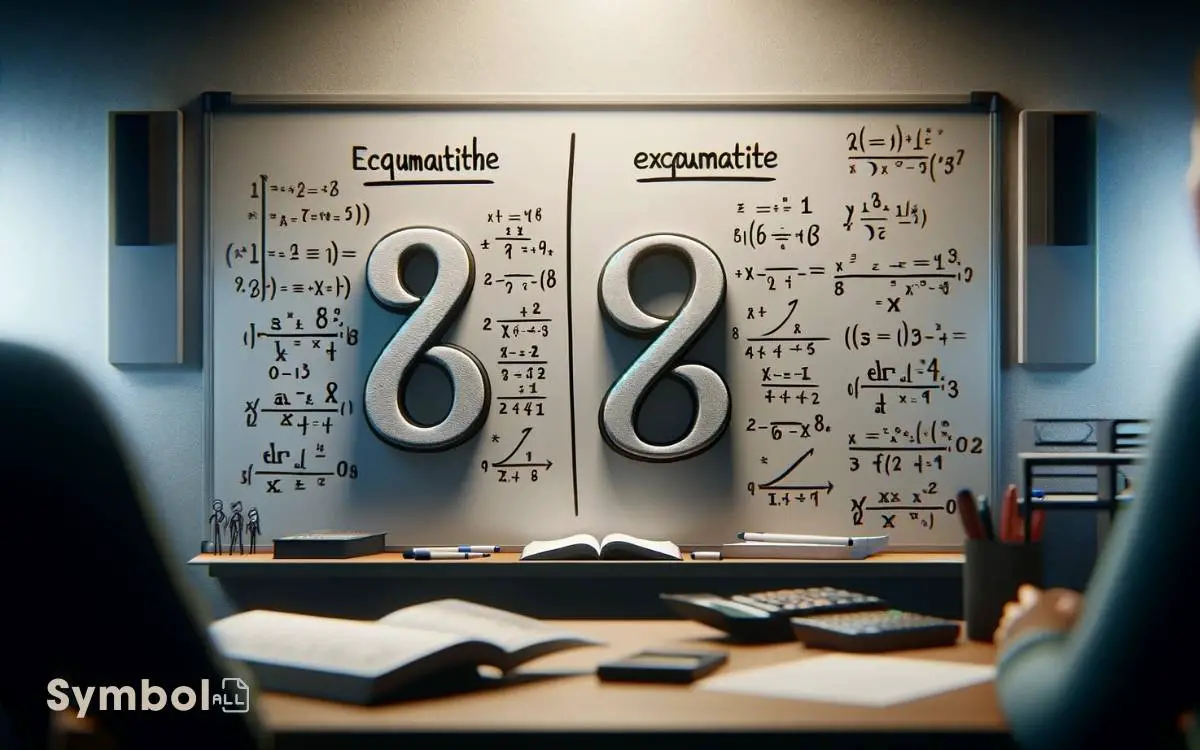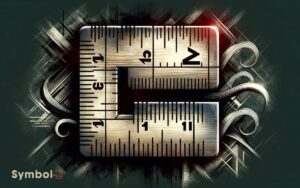Use an Inequality Symbol to Compare: Explains!
To compare using an inequality symbol, you need to understand symbols like ‘<‘, ‘>’, ‘≤’, and ‘≥’. Start by arranging numbers visually.
Remember, ‘<‘ points to the smaller number, and ‘>’ to the larger one. This method applies to numbers, variables, and algebraic expressions. You’ll systematically determine their relative values, enhancing your decision-making ability.
Avoid common pitfalls: misinterpreting symbols can skew comparisons. Double-check your work to ensure accuracy.
Mastery of these symbols and their proper application empowers you to make informed analyses across various scenarios. Absorbing these principles equips you with a deeper insight into comparative analyses.

Key Takeaways
Understanding Inequality Symbols
Inequality symbols serve as the backbone of mathematical comparisons, precisely distinguishing between values that aren’t equal. You’re likely familiar with the basic symbols: ‘<‘ for less than, ‘>’ for greater than, ‘≤’ for less than or equal to, and ‘≥’ for greater than or equal to. Inequality symbols enable us to compare numbers, expressions, and even variables in a concise and efficient way. For instance, inequality symbols explained with examples include writing 3 < 5 to show that 3 is less than 5, or x ≥ 7 to indicate that x is at least 7. These symbols play a vital role in problem-solving, allowing mathematicians to express relationships and constraints in equations and real-world scenarios.
Each plays a critical role in expressing relationships between numbers or expressions.
Understanding these symbols is essential for solving equations, evaluating expressions, and analyzing data. They allow you to quickly determine the relative size of two quantities without needing specific numerical values.
Mastery of inequality symbols empowers you to make accurate mathematical arguments and decisions, laying the groundwork for more complex mathematical concepts.
It’s a foundational skill that enhances your analytical capabilities in both academic and real-world scenarios.
Comparing Numbers
You’ve grasped the basics of inequality symbols; now, let’s turn your attention to comparing numbers. Through examples, you’ll learn to apply these symbols methodically, enhancing your understanding.
Practical tips will then solidify your ability to use these comparisons effectively in real-world situations.
Understanding Inequality Symbols
To effectively compare numbers, it’s essential to understand the function and application of inequality symbols. These symbols serve as the foundation for expressing the relationship between two values.
Primarily, you’ll encounter four symbols: greater than (>), less than (<), greater than or equal to (≥), and less than or equal to (≤). Each symbol precisely communicates how one number relates to another, indicating whether it’s larger, smaller, or potentially equal in value.
Mastery of these symbols allows for the methodical comparison of quantities, leading to accurate conclusions about their relationship.
It’s crucial to recognize that these symbols aren’t interchangeable; each carries a specific meaning that directly impacts the interpretation of the comparison being made.
Understanding their correct usage is fundamental in mathematical communication and analysis.
Examples of Number Comparisons
Let’s dive into practical examples to illustrate how we can apply these inequality symbols to compare numbers effectively.
Consider two numbers: 5 and 8. To compare, we determine which is greater. Since 8 is larger, we write 5 < 8, meaning 5 is less than 8. If we reverse the numbers, 8 > 5 indicates 8 is greater than 5.
Now, examine decimals: 3.5 and 3.45. Comparing digit by digit, we find 3.5 is greater, so 3.5 > 3.45.
For negative numbers, -2 and -5, remember the closer to zero, the larger. Thus, –2 > -5.
These examples demonstrate the methodical approach required: assess each number’s value, apply the correct inequality symbol, and ensure your comparison logically reflects their relationship.
Practical Application Tips
Understanding how to apply inequality symbols in number comparison not only enhances your mathematical skills but also sharpens your analytical thinking.
Begin by always arranging the numbers you’re comparing in a clear, linear fashion. This visual arrangement aids in discerning which is larger or smaller at a glance.
Remember, the symbol ‘<‘ means less than, pointing to the smaller number, while ‘>’ indicates greater than, directing towards the larger number.
Practice with real-life scenarios, such as comparing prices or evaluating distances, to embed these concepts deeply. It’s crucial to double-check your comparisons, especially in critical decision-making situations.
Developing a habit of questioning, ‘Is this truly greater or less than the other?’ fortifies your proficiency.
Through methodical practice, you’ll find comparing numbers with inequality symbols becomes second nature, enhancing both your mathematical acumen and decision-making capabilities.
Comparing Variables
When comparing variables, you’ll often use inequality symbols to determine their relative values. This process requires a methodical approach, ensuring you precisely understand the relationship between the variables in question.
For example, using ‘<‘ or ‘>’ allows you to state that one variable is less than or greater than another. It’s crucial to remember these symbols aren’t interchangeable and convey specific directional comparisons.
Moreover, when variables represent quantities, the comparison helps in predicting outcomes and making decisions based on their relative sizes. It’s also essential to consider the variables’ units of measurement to ensure the comparison is valid.
By meticulously analyzing the variables and applying the correct inequality symbol, you establish a clear, unambiguous understanding of their relationship, facilitating informed analysis and decision-making.
Comparing Algebraic Expressions
In comparing algebraic expressions, you must evaluate the expressions to determine their relative values accurately. It’s vital to consider variables, coefficients, and the operations involved.
Here’s how you can methodically approach this task:
| Expression 1 | Inequality Symbol | Expression 2 |
|---|---|---|
| 2x + 3 | < | 3x + 1 |
| 4y – 5 | > | 2y + 7 |
| 5z + 2 | = | 5z + 2 |
In the first row, you’re comparing expressions with different coefficients and constants. By isolating the variable, you’ll find the conditions under which one expression is less than the other. The second comparison involves simplifying both sides to understand the relationship better.
The third demonstrates an instance where two expressions are equivalent. This table serves as a practical guide to systematically analyze and compare algebraic expressions without delving into their practical applications.
Practical Applications
Let’s delve into how comparing algebraic expressions with inequality symbols finds practical application in real-world scenarios, ranging from financial planning to engineering design.
In the realm of financial planning, you’ll often compare your income and expenditures using inequalities to ensure your expenses don’t exceed your earnings. This method helps in budgeting effectively, allowing for savings and investments.
In engineering, inequalities play a crucial role in the design process. For instance, when determining the maximum load a bridge can safely carry, engineers use inequalities to compare the bridge’s capacity with potential loads.
This ensures safety and efficiency without over-engineering.
These applications demonstrate the importance of understanding and applying inequalities in making informed decisions and creating sustainable designs.
Common Mistakes to Avoid
When you’re working with inequality symbols, it’s crucial to understand the common pitfalls that can lead to errors.
Misreading symbols often results in reversing the intended comparison, while incorrect value order can fundamentally alter the inequality’s meaning.
Misreading Symbols
One common mistake you may encounter involves misinterpreting the meanings of inequality symbols, leading to incorrect comparisons.
It’s crucial to remember that ‘<‘ means less than, and ‘>’ means greater than. Misreading these symbols can significantly alter the meaning of a mathematical statement, causing confusion.
For instance, confusing ‘<‘ for ‘>’ when comparing numbers or quantities flips the relationship entirely, leading to a fundamental misunderstanding of the values in question.
To avoid this error, closely examine the direction in which the symbol points. Think of the symbol as an arrow or the open end of the symbol ‘eating’ the larger number.
This visualization helps in correctly interpreting the intended comparison, ensuring accuracy in your mathematical reasoning and analysis.
Incorrect Value Order
Incorrectly ordering values in a comparison can significantly impact your mathematical analysis and lead to erroneous conclusions. When you’re comparing quantities, ensuring the correct value order is essential for accuracy.
A mistake in the sequence not only distorts the relationship between the numbers but also affects the overall integrity of your work.
To illustrate, consider these common pitfalls:
- Placing a larger value on the wrong side of the inequality.
- Forgetting that the inequality symbol points towards the smaller value.
- Mixing up the symbols when transitioning from words to equations.
- Assuming the order without verifying through calculation.
Being methodical in your approach and double-checking your comparisons can prevent these errors. Remember, precision in mathematical communication is as critical as the calculations themselves.
Tips for Mastery
Mastering inequality symbols requires consistent practice and a deep understanding of their principles.
To excel, you must first grasp the fundamental concept that these symbols represent a relationship between values, indicating whether one is greater than, less than, or not equal to another.
Start by consistently practicing with real-life examples, which can solidify your comprehension.
Pay close attention to the direction of the symbol; it points to the smaller value. Also, remember that when dealing with negative numbers, the value that appears ‘larger’ might actually be the smaller.
Conclusion
Imagine you’re navigating the vast ocean, where your ship represents an equation and the stars are your guide, symbolizing inequality symbols.
As you chart your course, comparing numbers, variables, and algebraic expressions becomes as crucial as comparing the brightness of stars to avoid the treacherous waters of confusion.
Heed the constellations of common mistakes, and arm yourself with the compass of tips for mastery.
Only then can you navigate the mathematical seas with precision, ensuring your journey towards understanding is both accurate and enlightening.





